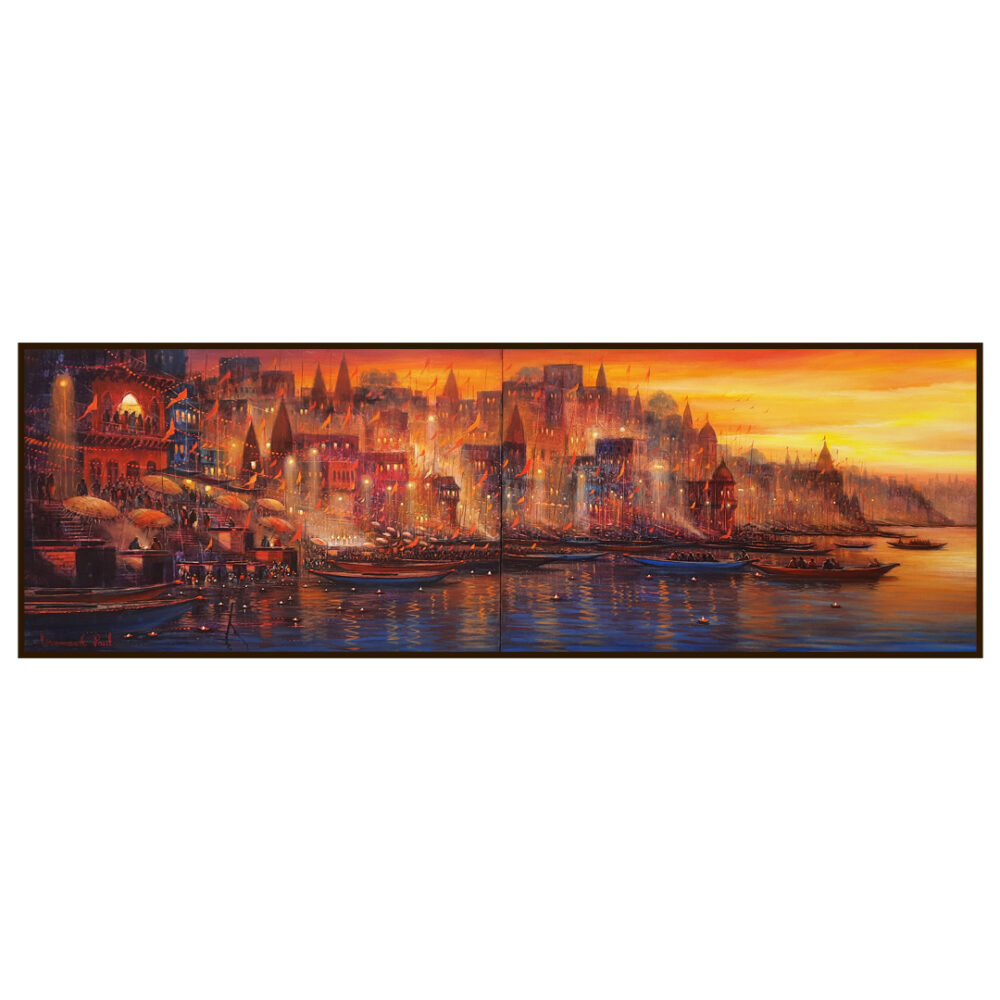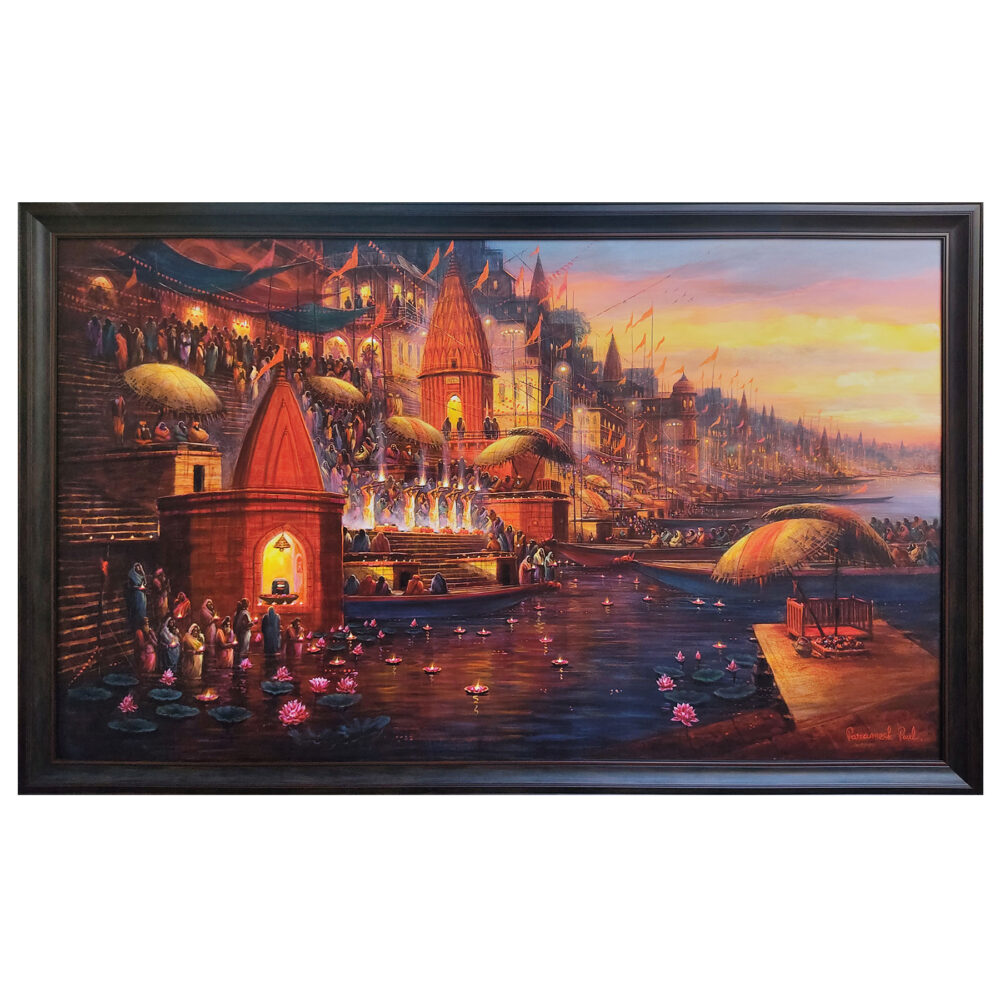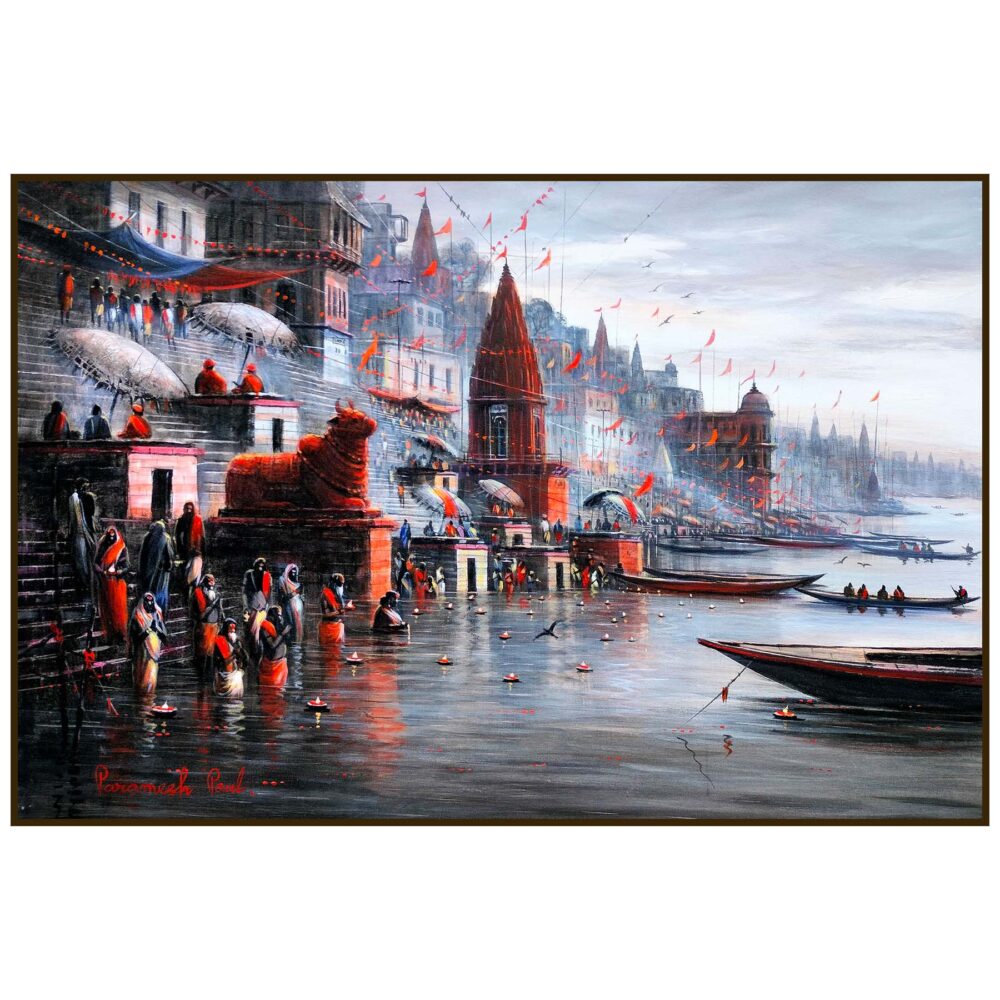THREADS OF REALISM
Through landscapes and cityscapes Paramesh Paul wishes to touch the core of reality and tries to expound a spiritual sensibility. Spirituality bordering around traditional religious feelings is the essence of his art. Through his works he analyses and investigate life, and strives to look deeper into the relation of people with nature and with religious emotions.
Paramesh Paul is a freelance artist from Mumbai. Paramesh Paul was born in a traditional potter family in a rural location of West Bengal. He acquired an artistic image of Durga and other gods and goddesses during the childhood. He is greatly in love with towns in India like Banaras, Haridwar, Rishikesh, Nabadwip Dham and other religious places that appear very often in his paintings. Water is a dominant theme in them, especially the river Ganges. This particular river is greatly associated with the religious and spiritual sentiments of the people of India.
Born in 1970, Paramesh Paul belonged from a traditional potter family with a rural environment of West Bengal. Art was genetically running through his blood. Sculpting clay images of gods was his primeval step towards his artistic sensibilities. Though he pursued his graduation from commerce stream; but the intrinsic inclination towards art took him to build his career as an artist. The initial decade of his profession in ISKON Temple had successfully instigated him towards naturalism and spirituality. This further assisted him to pave his way for the subjects that included both these elements. Soon he was recognized for his magnificent series of landscapes and cityscapes. Since then his paintings have been featured in numerous solo and group exhibitions in some of the reputed art galleries of India and abroad. They have lucratively become a great source of inspiration for many promising artists.
The enduring commitment to naturalism has provided Paramesh, an earnest constancy. Due to which we find his works as a sincere investigation of the threads of naturalism and realism. He has evolved his creativity by not restricting it to mere mimetic replicas, instead, he has skillfully captured the imageries to his cerebrals and put them on the two dimensional planes with a detailed analytical approach. He strongly believes that: Painting should be easily communicable to ordinary people. Therefore he does not go into much of formal jugglery. As a result, most of his paintings are made up of multiple layers that are quite revealing and mystical. They show a substantial relationship between aesthetics and creativity.
In terms of subject, as said earlier Paramesh is found to be an ardent landscapist and cityscapist. They have become an indigenous identity of his style. The massive architectural variety represented in his paintings of Kolkata, Mumbai, Delhi, Haridwar & Benaras offers a vast range of structural monuments. These historical edifices bring an interesting illusion of three-dimensionality in his paintings. It reflects the artist’s rational way of space articulation and compositional construction.
Amongst all, Paramesh Paul has enormously accentuated on his ‘the most’ acclaimed series, i.e. Benaras. The mysticism and spirituality that is offered by this city has been mysteriously encapsulated by him in the present exhibition.
Benaras is the place which has an intimate connection with a host of legendary figures and mythical characters like Gautam Buddha, Mahavira, Kabir, Tulsi Das, Shankaracharya, Ramanuja and Patanjali. It is a veritable paradise for Hindu pilgrims, who throng the Ghats of the Ganges for spiritual rewards like deliverance from sin and attainment of heavenly bliss and emancipation from the eternal cycle of birth and death.
This, one of the most visited holy places of the planet has been diligently displayed by the artist in all his creations. Each canvas being a sole example of its idiosyncraticism, has revealed Pauls enormous artistic sensibilities. He has captured the beauty of the city with a microscopic eye, bringing for us the gentle waters of the Ganges, the boat rides, the morning worships at sunrise, the evening Ganga aartis’, the high banks of the ancient ghats, the array of shrines, the myriad temple spires, the palaces at water’s edge, the ashrams, the pavilions and the palm and cane parasols.
Looking at his paintings the viewer drives through the enigmatic voyage of peacefulness and spirituality. The chanting of mantras, the fragrance of incense, the smoke of lamps, the devotional hymns – all slowly comes to him as he becomes the part of the exhibit. An atmospheric aura is formulated that fills the air with devotion. By offering this mystifying experience Paramesh proficiently transcends the beholder from this world to the divine world. The paintings’ overwhelms the onlooker so much that he is forced to take the trip to this religious world on the banks of Ganga.
With brush and paint he constructs an imaginative alley for the viewer to allow him to walk inside the frame. The appealing picturesque beauty, the grandiosity and the vastness produced, takes him on a sublime journey. The spectator no-more remains just the spectator but instead becomes the member of the picture. He is automatically absorbed and thus instinctively becomes part of the entire painted scenario. This is how Paramesh successfully creates an intricate connection between the watcher and the work of art.
Every painting portrays either Lord Shiva or Ganga emphasizing on the main essences of Benaras. This is how Paramesh Paul deftly sheds light on the true spirit of the city and offers altogether a different experience through his paintings.
-
Panoramic Varanasi
24 x 72 inches -
Ganga Aarti at Banaras
36 x 60 inches -
Majestic Varanasi
24 x 36 inches




